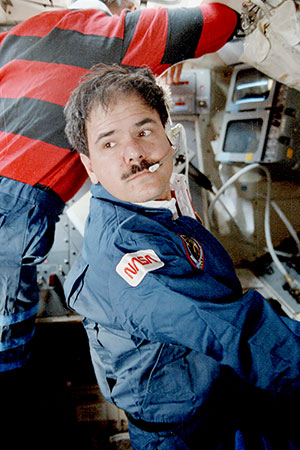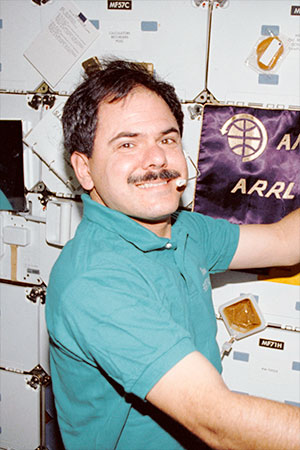 advertisements advertisements
|

|
Ron Parise, astronaut-astronomer who flew on shuttle, dies at 56
May 11, 2008 — An astronomer-turned-astronaut, who flew as a payload specialist on board NASA's two shuttle missions dedicated to astronomy, Ron Parise, 56, died on Friday (May 9) of a brain tumor after fighting the cancer for three years.
Parise's path to space came as a result of his work at the Computer Science Corporation (CSC), where he helped develop the flight software, electronic system design and mission plan for the Ultraviolet Imaging Telescope, one of the instruments for NASA's ASTRO payload. In 1984, he was selected by NASA as a payload specialist to fly with the UIT on the STS-61E mission, scheduled for launch in March 1986.
His flight postponed as a result of the January 1986 loss of space shuttle Challenger, Parise's first mission came as part of the STS-35 crew aboard Columbia in December 1990. NASA's first manned mission dedicated to studying astronomy, the nine-day STS-35 mission flew a package of three ultraviolet telescopes in the orbiter's payload bay. Parise, together with Jeffrey Hoffman and Sam Durrance, became the first three astronomers to operate telescopes in space, observing 135 targets including comet Levy, the planet Jupiter and the supernova in the Large Magellanic Cloud.
Parise flew once again with the ASTRO payload in March 1995 on the shuttle Endeavour. A member of the STS-67 crew, Parise, again with Durrance, led the operation of the trio of ultraviolet telescopes, which was highlighted by the detection of primordial helium in intergalactic space. The discovery provided confirmation for a prediction of the Big Bang theory on the formation of the universe.
In total, Parise logged more than 614 hours and travelled 10.6 million miles in space. After his second flight, Parise returned to the Computer Science Corporation, working at the Goddard Space Flight Center in Maryland in the area of advanced communications planning for manned space missions.
Born on May 24, 1951, in Warren, Ohio, Ronald Anthony Parise received his bachelor of science in physics, with minors in mathematics, astronomy, and geology from the Youngstown State University in 1973. He then attended the University of Florida, where he earned his master and doctorate in astronomy in 1977 and in 1979, respectively.
Before joining CSC in 1980, Parise worked on developing avionics requirements and performing failure analyses for NASA missions for Operations Research Inc. In addition to his accomplishments in space, Parise also engaged in a number of astronomical research projects utilizing data from ground-based observatories, the Copernicus satellite (OAO-3) and the International Ultraviolet Explorer, which resulted in several professional publications.
An amateur radio enthusiast since the age of 11, Parise became the first ham to operate packet radio from space using the Shuttle Amateur Radio Experiment (SAREX), a payload he guided through development. During his two missions, he spoke to hundreds of hams on the ground, including many students. After his flights, he remained an active member of the ham community, inspiring students to join the hobby and volunteering in the development of the hardware now aboard the International Space Station.
A two-time recipient of the NASA Space Flight Medal, Parise once said he would have waited forever for a flight for what "must be the greatest adventure of all time."
"To leave our home world and look back at it from space is a most incredible experience," he said in 1998 in reply to the original Ask An Astronaut website.
Parise is survived by his parents Henry and Catherine, his sister Rita, his wife Cecelia and two children, Nicholas and Katie. A funeral will be held on Saturday in Burtonsville, Maryland.
His family has established a scholarship in his memory at Youngstown State University. |
|

Astronaut Ron Parise works on board the space shuttle Columbia during his first space flight in December 1990. (NASA)

Astronaut Ron Parise sets up SAREX, the Shuttle Amateur Radio Experiment, aboard space shuttle Columbia in 1990. (NASA) |
|

© 1999-2025 collectSPACE. All rights reserved.
|
|

|

|
